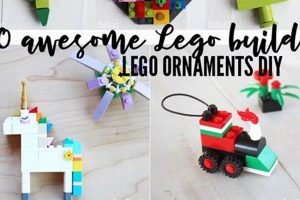Large, self-constructed holiday decorations designed for the Christmas season represent a growing trend in seasonal crafting. These oversized embellishments, often created from readily available materials, provide a personalized alternative to commercially produced decorations and offer a unique visual impact, enhancing both indoor and outdoor festive displays. For instance, a sizable sphere constructed from chicken wire and adorned with colorful fabric scraps can serve as an eye-catching lawn ornament.
The creation of substantial, homemade festive adornments offers numerous advantages. It allows for significant cost savings compared to purchasing equivalent items from retail outlets. Furthermore, the process encourages creative expression and personalization, leading to decorations that reflect individual styles and preferences. Historically, crafting homemade ornaments was a prevalent tradition, particularly during times of economic hardship, fostering resourcefulness and community engagement.
The subsequent sections will explore various techniques, materials, and design ideas for constructing impressive holiday decorations, including guidance on structural integrity, weatherproofing, and visual appeal. Consideration will also be given to safety precautions necessary when working with large-scale projects and outdoor installations.
Construction Advice for Oversized Holiday Embellishments
The successful creation of significant, handcrafted festive decorations requires careful planning and execution. Attention to detail throughout the construction process ensures both aesthetic appeal and structural integrity.
Tip 1: Material Selection is Paramount: Choose weather-resistant materials appropriate for the intended environment. Outdoor decorations should utilize treated wood, durable plastics, or sealed metals to withstand exposure to the elements. Indoor ornamentation can accommodate lighter materials such as cardboard or fabric, provided they are treated with flame retardant.
Tip 2: Structural Integrity is Essential: Ensure that the framework of the decoration can support its own weight and resist external forces such as wind or snow. Internal supports, reinforced joints, and secure anchoring systems are critical for maintaining stability.
Tip 3: Weight Distribution Requires Careful Consideration: Distribute weight evenly throughout the structure to prevent imbalance and potential collapse. Heavy components should be positioned at the base of the decoration, while lighter elements should be placed higher up.
Tip 4: Scale and Proportion Should be Harmonious: Maintain a balanced visual aesthetic by adhering to principles of scale and proportion. Consider the surrounding environment and ensure that the decoration is appropriately sized and shaped for its intended location.
Tip 5: Lighting Integration Enhances Visual Impact: Incorporate lighting elements strategically to accentuate the decoration’s features and create a festive ambiance. Utilize energy-efficient LED lights and ensure that all electrical connections are properly insulated and weatherproofed.
Tip 6: Surface Finishing Improves Durability: Apply a protective coating to the exterior of the embellishment to resist weathering and prolong its lifespan. Sealants, paints, and varnishes should be selected based on the material of construction and the intended environment.
Tip 7: Secure Mounting Prevents Accidents: Implement a secure mounting system to prevent the decoration from falling or being dislodged by wind or impact. Utilize ground anchors, support cables, and appropriate fasteners to ensure stability and prevent potential hazards.
Adherence to these guidelines will result in durable, visually appealing holiday adornments that enhance the festive atmosphere and withstand seasonal conditions.
The following sections will delve deeper into specific design ideas and construction techniques, providing further guidance on creating impactful holiday displays.
1. Material Weight and Strength
The interplay between material weight and strength is a critical determinant of both the visual impact and the structural integrity of large, self-constructed holiday decorations. Inadequate consideration of these factors can lead to aesthetic compromises, structural failures, and potential safety hazards.
- Load-Bearing Capacity of Framework Materials
The chosen framework materials must possess the requisite load-bearing capacity to support the weight of the decorative elements. For instance, a lightweight wire frame intended to hold heavy glass ornaments will likely deform or collapse. Conversely, over-engineered frameworks employing excessively robust materials may increase the overall weight to an unmanageable level, complicating installation and potentially straining supporting structures.
- Wind Resistance and Stability
Outdoor installations must withstand wind loads. Heavier materials, while offering increased resistance to bending and breakage, also present a larger surface area for wind to act upon. This can result in increased stress on anchoring systems and potentially dislodge the entire structure. Lightweight materials, while less resistant to direct impact, may offer reduced wind resistance due to their smaller surface area. Careful selection balances wind resistance and material durability.
- Material Density and Visual Perception
The apparent size and visual impact of a decoration are inherently linked to the material density. A hollow, lightweight sphere may appear insubstantial even at a large scale. Alternatively, a solid, dense material may create an impression of excessive bulk. The selection of materials with appropriate density allows for the creation of a visually compelling ornament that conveys both size and solidity without unnecessary weight.
- Impact of Material Selection on Installation Feasibility
The cumulative weight of the chosen materials directly impacts the feasibility of installation. An excessively heavy ornament may require specialized equipment and a larger installation team, increasing both the cost and complexity of the project. Consideration of material weight in relation to installation constraints is crucial for ensuring a safe and efficient deployment process.
The successful design and construction of substantial holiday decorations require a nuanced understanding of the interplay between material weight and strength. An informed selection process, based on a careful assessment of structural requirements, environmental conditions, and installation constraints, is essential for achieving a visually impressive and structurally sound final product.
2. Structural Support Framework
The structural support framework constitutes a critical, often underestimated, component in the successful design and implementation of substantial, handcrafted holiday decorations. The integrity of this framework directly influences the longevity, stability, and overall visual impact of the finished ornament. Without a well-engineered support structure, even the most aesthetically pleasing designs are prone to collapse, deformation, or premature deterioration. For example, consider a large, spherical ornament constructed from lightweight, decorative mesh. Absent a robust internal framework, the mesh will likely sag and lose its intended shape, especially when exposed to environmental stressors such as wind or precipitation. The framework, therefore, acts as the skeleton upon which the decorative elements are layered, providing the necessary rigidity to maintain the desired form.
Furthermore, the design of the structural support framework dictates the types of materials and construction techniques that can be employed for the outer decorative layer. A strong, load-bearing framework allows for the incorporation of heavier, more durable materials, resulting in a more visually impressive and weather-resistant ornament. Conversely, a weak or inadequate framework limits the choice of decorative materials, potentially compromising the aesthetic appeal and long-term performance of the ornament. For instance, a large, illuminated star constructed with a flimsy wooden frame would be unable to support the weight of numerous light fixtures, necessitating the use of lighter, less durable alternatives, thus diminishing the overall brilliance and visual impact of the star. The structural framework’s geometry must also accommodate attachment points for anchoring systems, ensuring secure installation and preventing displacement by external forces.
In conclusion, the structural support framework is not merely an ancillary element but rather an integral and essential component of any successful large, self-made holiday decoration. Its design and construction require careful planning, the use of appropriate materials, and a thorough understanding of structural engineering principles. A robust and well-engineered framework ensures the ornament’s stability, longevity, and visual impact, ultimately contributing to a safer and more aesthetically pleasing festive display. The challenges associated with constructing these frameworks often involve balancing material cost, weight, and structural performance, requiring creative problem-solving and a commitment to quality craftsmanship.
3. Weather Resistance Coating
The application of a weather-resistant coating is a critical step in the creation of durable, large-scale, self-made holiday decorations intended for outdoor display. This protective layer serves as a primary defense against environmental factors, including precipitation, ultraviolet (UV) radiation, temperature fluctuations, and humidity, all of which contribute to the degradation of the underlying materials. Without an effective coating, materials such as wood, metal, and certain plastics are susceptible to warping, rusting, fading, and cracking, leading to premature failure of the decoration. For instance, a large wooden snowflake, if left untreated, will absorb moisture, causing it to swell, distort its shape, and eventually rot. The choice of coating should align with the base material’s properties and the anticipated environmental conditions.
Different coating types offer varying degrees of protection and aesthetic qualities. Polyurethane coatings are valued for their durability and resistance to abrasion, making them suitable for decorations exposed to physical contact or handling. Acrylic coatings provide excellent UV resistance, preventing color fading and maintaining the visual appeal of painted surfaces. Epoxy coatings offer exceptional chemical resistance, making them appropriate for decorations located near roadways where they may be exposed to de-icing salts or other corrosive agents. Silicone coatings provide a flexible barrier, preventing moisture intrusion and minimizing the risk of cracking due to temperature-induced expansion and contraction. The selection process should consider both the protective characteristics and the aesthetic impact of the coating on the finished product, using techniques like testing small samples of the decoration to ensure that the product can withhold weathering. For example, a large, illuminated star constructed from painted metal would require a UV-resistant clear coat to prevent the paint from fading and the metal from corroding.
In summary, weather-resistant coatings are indispensable for ensuring the longevity and structural integrity of substantial holiday decorations intended for outdoor use. Their application represents a proactive measure to mitigate the damaging effects of environmental exposure, preserving the aesthetic appeal and extending the lifespan of these festive creations. The selection of an appropriate coating requires careful consideration of the base material, environmental conditions, and desired aesthetic outcome. While the initial investment in weather-resistant coatings may represent an added expense, it ultimately provides a cost-effective solution by minimizing the need for frequent repairs or replacements, contributing to the long-term sustainability of the holiday display.
4. Visual Scale and Proportion
Visual scale and proportion are fundamental design considerations that profoundly influence the aesthetic impact of substantial, self-made holiday decorations. The relationship between an ornament’s dimensions and its surrounding environment, as well as the harmony among its constituent parts, dictates its perceived attractiveness and integration within the festive setting. Disregard for these principles can result in decorations that appear either underwhelming or overwhelming, disrupting the overall visual balance of the display. For instance, a disproportionately large ornament in a small yard might dominate the space, creating an impression of clutter rather than festivity. Conversely, an ornament that is too small may become visually insignificant, failing to contribute to the desired celebratory atmosphere.
The importance of visual scale and proportion extends beyond mere aesthetics, impacting the perceived quality and craftsmanship of the decoration. A well-proportioned ornament reflects a meticulous approach to design, conveying a sense of attention to detail and artistic skill. The placement and arrangement of decorative elements, such as lights, ribbons, and embellishments, must adhere to principles of visual balance to create a cohesive and visually appealing composition. For example, the spacing and size of lights on a large star ornament should be carefully considered to ensure uniform illumination and prevent any areas from appearing overly bright or dim. Real-life examples demonstrate this clearly: professionally designed holiday displays often feature ornaments that are scaled and proportioned to complement the architecture of the building and the surrounding landscape, creating a seamless and harmonious visual experience.
In conclusion, visual scale and proportion represent critical design elements in the creation of visually compelling and aesthetically pleasing large, self-constructed holiday decorations. Careful consideration of these principles ensures that the ornament integrates seamlessly within its environment, contributes to the desired festive atmosphere, and reflects a high level of craftsmanship. Overcoming challenges related to scale and proportion often requires careful planning, experimentation with different sizes and shapes, and attention to the principles of visual balance. By prioritizing these elements, creators can elevate their holiday displays from simple decorations to visually stunning works of art, thereby enhancing the overall enjoyment of the holiday season.
5. Secure Mounting System
The integration of a secure mounting system is paramount to the successful deployment of substantial, self-made holiday decorations. The size and weight of these ornaments present a significant risk of displacement or collapse if not properly secured. A substandard mounting system can lead to property damage, personal injury, or even fatalities, particularly during inclement weather conditions. Therefore, the selection and implementation of a robust anchoring method are not merely aesthetic considerations but rather essential safety protocols. Real-world examples underscore the potential consequences of inadequate mounting: Instances of large decorations being dislodged by wind gusts, resulting in damage to structures and creating hazards for pedestrians, are well-documented. The connection between secure mounting and the overall integrity of a large holiday ornament is one of cause and effect; a flawed system directly causes the ornament to fail.
The specific type of secure mounting system required is contingent upon several factors, including the size and weight of the ornament, the composition of the supporting structure, and the prevailing environmental conditions. Options range from ground anchors and tension cables to specialized brackets and fasteners. Ground anchors, for instance, are commonly used to secure large, freestanding ornaments to the earth, providing resistance against tipping or toppling. Tension cables offer additional support, particularly for ornaments suspended from elevated structures, distributing the load and minimizing stress on individual attachment points. Furthermore, the choice of materials for the mounting system should align with the environment. Stainless steel or galvanized steel components are frequently preferred for outdoor installations due to their resistance to corrosion. Practical application involves calculating the forces expected to act on the ornament, taking into account wind speed, snow load, and the ornaments surface area, then selecting a mounting system with a sufficient safety margin.
Concluding, a secure mounting system constitutes an indispensable element in the safe and effective display of large, DIY Christmas decorations. Its importance transcends aesthetic considerations, serving as a critical safeguard against potential hazards. Understanding the factors that influence mounting system selection and implementing appropriate techniques is essential for ensuring the long-term stability and safety of these festive installations. While challenges may arise in balancing cost-effectiveness with structural integrity, prioritizing safety remains paramount, preventing accidents and preserving the festive spirit.
Frequently Asked Questions
The following section addresses common inquiries regarding the planning, construction, and implementation of oversized, do-it-yourself Christmas ornaments.
Question 1: What materials are most suitable for constructing outdoor decorations capable of withstanding winter weather?
Durable, weather-resistant materials such as treated lumber, PVC piping, exterior-grade plywood, and galvanized steel are recommended for outdoor ornamentation. These materials offer resistance to moisture, temperature fluctuations, and UV radiation.
Question 2: How can the structural integrity of a large ornament be ensured, especially when exposed to wind?
A robust internal framework constructed from metal or reinforced wood is essential. Secure anchoring to the ground or a stable structure is also critical, employing ground stakes, guy wires, or appropriate mounting hardware.
Question 3: What safety precautions should be taken when installing substantial decorations, particularly those involving electrical components?
All electrical connections must be weatherproofed and comply with local electrical codes. The use of ground fault circuit interrupters (GFCIs) is strongly advised to prevent electrical shock. When working at heights, appropriate safety equipment, such as ladders and harnesses, should be utilized.
Question 4: How can the visual scale and proportion of the ornament be optimized to complement its surroundings?
Consider the dimensions of the installation site and the architectural style of the adjacent structures. Scale the ornament accordingly to avoid overwhelming the space or appearing insignificant. Employ design principles such as the golden ratio to achieve visual harmony.
Question 5: What types of coatings provide effective protection against moisture and UV damage?
Exterior-grade paints, varnishes, and sealants formulated for weather resistance are recommended. Products containing UV inhibitors will help prevent fading and degradation of the underlying materials. Regular reapplication may be necessary to maintain optimal protection.
Question 6: How can the weight of the ornament be minimized to facilitate installation and reduce stress on the supporting structure?
Utilize lightweight materials such as foam, plastic sheeting, or hollow-core construction techniques. Minimize the use of heavy embellishments and distribute the weight evenly throughout the structure.
Adherence to these guidelines will contribute to the creation of durable, aesthetically pleasing, and safe holiday adornments.
The subsequent section will provide project ideas and inspiration for designing personalized holiday decorations.
Conclusion
The preceding analysis of huge DIY Christmas ornaments has illuminated critical aspects of their design, construction, and implementation. From the selection of appropriate materials and the engineering of robust support structures to the application of weather-resistant coatings and the implementation of secure mounting systems, each element contributes to the overall success and longevity of these festive creations. Neglecting any of these factors can compromise the structural integrity, visual appeal, and safety of the final product.
The creation of large-scale, handcrafted holiday decorations represents a significant undertaking, demanding careful planning, skillful execution, and a commitment to safety. While the challenges involved may seem daunting, the resulting displays offer a unique opportunity for creative expression and the enhancement of community spirit. Continued adherence to sound engineering principles and innovative design solutions will ensure that these festive traditions endure for generations to come, with their long-term sustainability being a key element to monitor.







